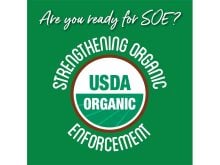The U.S. shut down the appeal process in 2019, and the country is expected to keep standing in the way of reform
SASKATOON — Don’t hold your breath waiting for a fix to the World Trade Organization’s hobbled dispute settlement mechanism, says a trade expert.
The WTO has set a December deadline for coming to an agreement on dispute settlement reform.
Related stories:
- WTO may be close to fixing dispute settlement system
- Opinion: WTO slides into a vacuum, EU slides into nationalism
“I doubt that will happen,” said Sharon Bomer Lauritsen, an agriculture trade policy consultant and former lead agricultural trade negotiator with the U.S. Trade Representative.
Read Also

Trump’s tariffs take their toll on U.S. producers
U.S. farmers say Trump’s tariffs have been devastating for growers in that country.
She told delegates attending a webinar hosted by North American Agricultural Journalists that former U.S. President Donald Trump’s administration upended the dispute settlement system and is unlikely to repair it if he is re-elected in November.
She thinks vice-president Kamala Harris might try to make some progress at the WTO if she is elected, but doubts that key issues can be resolved.
The WTO’s dispute settlement system is still functioning. Disputes are being brought forward and panels are being established to hear those disputes.
The problem is that there is no way to appeal decisions, so dozens of panel reports have been appealed into the void since the Appellate Body stopped functioning in 2019.
“Part of the issue is countries don’t understand how serious the United States takes the issues with the former appellate body system,” said Bomer Lauritsen.
The U.S. insists that there needs to be a second-tier appellate body process.
However, the bigger issue is that the U.S. and other countries think it is up to importing nations to decide what constitutes a national security issue.
The Trump administration tried to do that with steel and aluminum.
“The U.S. made that case and the (WTO) panel ruled against us and that is a huge issue for the United States,” she said.
“Unless countries agree that it’s up to the importing country to decide what is national security, I don’t see this being fixed in either administration.”
Joe Glauber, senior research fellow at the International Food Policy Research Institute and former U.S. Department of Agriculture chief economist, said a non-functioning WTO is a big problem.
“The only way you’re now able to get any sort of trade negotiation is this very ham-handed way of raising tariffs,” he said.
And agriculture is often the target of those tariffs, even when it is not part of the original dispute.
Bomer Lauritsen said there would be stark contrasts between a Trump and Harris administration when it comes to trade policy.
“Tariffs have been front and centre for Trump,” she said.
She thinks a Harris administration would continue what current President Joe Biden has done, which is to actively engage at the WTO rather than attempting to dismantle it.
And there will be no comprehensive trade agreements under Harris, just smaller “one-off” agreements.
Bomer Lauritsen said there will initially be major disruptions under a Trump administration but eventually his policies could result in some meaningful trade agreements that benefit U.S. agriculture.
In the short-term, she believes U.S. soybeans could be hit hard once again, although the USDA will likely come out with a partial bailout for farmers.
With Harris there will be more stability and business certainty, but her policies will take longer to help agriculture and will have less of an overall impact.
Both experts feel it is unlikely Trump would be successful in applying 10 to 20 per cent across-the-board tariffs, which is something he has repeatedly promised during his presidential campaign.
“Congress will have a lot to say if a Trump administration goes down that path, to try and slow it down,” said Bomer Lauritsen.
She believes it is another Trump negotiating threat.
Glauber agreed that a blanket tariff is highly unlikely, but he does think Trump will once again target Chinese imports.
And China would likely retaliate against U.S. soybeans. The last time that happened U.S. soybean plantings plummeted by five million acres.
“Brazil really had to step up production, and unfortunately, that’s not area we’re going to get back,” he said.
“So, I worry about those longer run implications with another trade war.”
Both trade experts were asked to provide their thoughts on proposed U.S. legislation that would exclude imported feedstocks from qualifying for the new 45Z Clean Fuel Production Tax Credit.
“I worry about an overly protectionist market, to just exclude any sort of oils coming in,” said Glauber.
The intent of the proposed legislation is to curtail the tide of sometimes fraudulent used cooking oil coming into the country, but it would also affect other feedstocks.
“I mean, Canada, for example, has been selling a lot of canola to us that has ended up in biodiesel,” he said.
Bomer Lauritsen said a tax credit that is available only to domestic producers would violate WTO rules.
“That invites retaliation at a certain period of time if countries are upset enough,” she said.
















